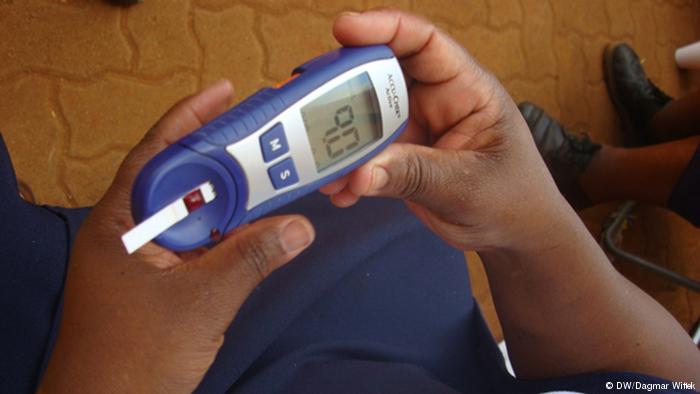
More than 14 million people have been diagnosed as having the disease in Africa according to statistics from the International Diabetes Federation (IDF). So we, African should learn more this phenomenon.

Diabetes occurs when the body is unable to regulate the amount of glucose (sugar) in the blood. Carbohydrate foods are broken down to produce glucose, causing the blood glucose level (BGL) to rise. The liver also stores glucose, which is used to avoid low BGL when we’re not eating.
Insulin is a hormone produced by the pancreas, which regulates the BGL between certain limits. It can remove glucose from the blood and transport it into the cells of the body where it is needed for energy. Insulin also regulates the production of glucose by the liver and switches off production when the BGL is high.
Normally, the body produces enough insulin to keep the BGL between ideal levels at all times by removing excess glucose from the blood and regulating how much the liver produces.
But people with diabetes are not able to remove excess glucose from the blood and the BGL rises. There are two types of diabetes:
Type 1 Diabetes
- usually starts in children and young people under the age of 30
- comes on quite quickly
- the persons own immune system destroys the cells in the pancreas that makes the insulin
- cannot make insulin and need to have insulin injections right from the start.
Type 2 Diabetes
- usually develops in older people
- begins gradually
- some insulin is still produced, but it does not work properly, known as insulin resistance
- managed by diet and exercise, ad some people may need tablets or insulin as diabetes progresses.
What causes Type 2 Diabetes?
The causes of Type 2 Diabetes are a combination of:
- Family history Getting older
- Being overweight
- Being physically inactive
Diabetes: explained
When food is eaten it is digested in the stomach and intestines where it is broken down into glucose, and then absorbed into the blood stream. Glucose then moves into the cells of the body (mainly muscle cells) to be used as energy.

Each cell has a ‘door’ (receptor) that can allow glucose to enter. However, this door stays locked until insulin arrives as the key to ‘unlock’ it. When insulin is present, and the door is opened, glucose can enter the cell to be used as fuel.

With diabetes, glucose is unable to travel to the cells due to a lack of insulin or insulin resistance. This means too much glucose remains in the blood, causing high blood glucose readings. Excess body fat ‘clogs’ the lock, making it harder for the insulin to open the door. By losing weight, it is easier for the insulin to do its job and therefore achieve good BGL control.


The lows of highs
High blood glucose levels or ‘hyperglycaemia’ occurs when diabetes is not well managed, shown by the red line in the graph below. The grey line shows blood glucose levels for someone without diabetes. When blood glucose levels are between 4 and 8 the body works at its best.

Serious damage occurs to the nerves, brain, blood vessels and organs in the body when blood glucose levels are repeatedly high or low. High blood glucose levels in particular can cause damage to small blood vessels, leading to:
- Diabetic retinopathy: blood vessels at the back of the eye are damaged, which can lead to loss of sight.
- Diabetic kidney disease: damage to the kidney blood vessels.
- Diabetic neuropathy: nerve damage. This damage may be particularly severe in the legs and feet leading to serious feet problems.
Many people with diabetes also have high cholesterol and triglycerides in their blood, which increases the risk of having a heart attack or stroke.
Is there a cure for diabetes?
Research is now showing that significant weight loss can reverse Type 2 diabetes. This is exciting news and provides good reason to make changes to your lifestyle. Even losing a small amount of weight gives you better blood glucose control and can help prevent complications from diabetes. Diabetes is treated and delayed by:
- Healthy eating to lose weight if overweight
- Being more physically active
Learn More: Benefits of exercise if you have type 2 diabetes.
A healthy diet and exercise is essential for taking control of blood glucose levels, and therefore diabetes. But some people with diabetes will also need the help of tablets and/or possibly insulin injections. So in short, diabetes can be controlled by:
- A healthy diet with exercise
- A healthy diet with exercise + tablets
- A healthy diet with exercise + insulin
- A healthy diet with exercise + tablets + insulin
References: Daibetes.org.uk & Ethoshealth.com.au
more recommended stories
 New Director Appointed: Burao Hospital’s Fall and the Fight for Revival
New Director Appointed: Burao Hospital’s Fall and the Fight for RevivalBurao Hospital begins a new chapter.
 Somaliland Presidency Delivers 10 Vital Dialysis Machines to Hargeisa Group Hospital
Somaliland Presidency Delivers 10 Vital Dialysis Machines to Hargeisa Group HospitalHargeisa – Somaliland – The President.
 Women in Libya Struggle for Reproductive Healthcare Amidst Post-Storm Devastation
Women in Libya Struggle for Reproductive Healthcare Amidst Post-Storm DevastationHealth experts have raised concerns about.
 Over 90 Students Hospitalized in Kenya over Mystery Illness
Over 90 Students Hospitalized in Kenya over Mystery IllnessMore than 90 students from Eregi.


Leave a Comment